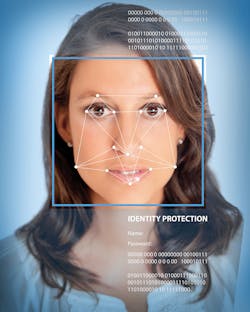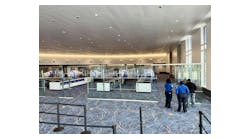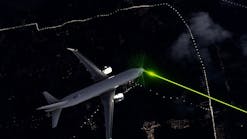The continued growth of international travelers to Orlando had created a major challenge for Orlando International Airport (MCO) and U.S. Customers and Border Protection (CBP) agents on site.
John Newsome, chief information officer for the Greater Orlando Aviation Authority (GOAA), said wide body aircraft from Europe and South America arrive at the airport every afternoon, creating a crush of passengers on the Federal Inspection Station (FIS). Travelers coming into the airport could wait hours in line as CBP officers worked to clear them.
But with little chance of more officers coming to the facility, GOAA turned to biometric screening to tackle the wait times while maintaining strong security.
“What we’re seeing here is it’s reducing the time in the federal inspection station by at least half,” Newsome said. “We’re not going to be able to have more CBP officers…but we can get twice the throughput with no additional officers.”
GOAA took a major step into biometrics in April when its board approved $4 million to enhance entry and exit biometrics at MCO by late summer. Exit screeners will be deployed at 30 gates as part of the program, making Orlando one of the first airports in North America to use facial recognition technology for all international traffic.
Newsome said $3 million will go to the exit portion of the project. The remaining $1 million is split between infrastructure costs and purchasing cameras for the entry portion of the project. CBP is testing cameras now and will determine which equipment MCO will purchase.
MCO has embraced biometrics deployment since U.S. Customs and Border Protection officials have pushed the technology. Newsome said the airport was one of the first to deploy the automated passport control kiosks utilizing biometrics.
The success of the program and willingness to embrace technology had GOAA asking to be part of the early testing of entry/exit biometrics deployment. Newsome said MCO was the third airport selected for testing in the CBP pilot program.
The airport got an e-gate on loan from the manufacturer and deployed it at Gate 80. SITA is a contractor for MCO and it worked on the software portion of the pilot.
“It was a relationship that continued to grow and we were able to support them in their desire to do a pilot,” Newsome said. “We were able to bring the pieces together.”
Newsome said biometrics screening isn’t just about enhanced security. It also provides greater customer service.
“We want our visitors to feel like they’re well-treated,” Newsome said. “Having them stand in line three hours to get through the FIS is not good customer service.”
Adding exit biometrics improves customer service further, Newsome said, by making it so passengers don’t have to search for documents to board a plane.
He said it also allowed the airport to load a British Airways 777 in 20 minutes.
“It’s so hassle-free that it’s a great thing for our passengers,” Newsome said. “It’s no fumbling, no concern about having the right page presented, having to use your bar code on your cellphone or any of that kind of stuff.”
Newsome said the e-gates don’t take up additional room and just need 120 volt connection and a couple of Ethernet data cables. The airport was able to take out the boarding gate readers and use the existing conduit to run the wiring.
The cost of installation was also less expensive than people though, he added.
“It’s important for us and the economy that people get in quickly,” said Sean Farrell, director of strategy and innovations for SITA. “This program has certainly expedited that because it’s very important to this community that the conditions here and international travelers that people can enter and exit expeditiously.”
“Reducing the entry time by 50 percent is a big dang deal for us,” Newsome said.
Newsome said the technology is mature and the infrastructure needs are minimal, so widespread biometric rollout hasn’t been too challenging.
“The only big challenge is there are so many partners involved and coordinating among them,” he said. “But we found that a number of airlines that provide international service here are really eager.”
Biometrics builds on success
Biometric security is gaining a major foothold in North America in 2018.
The Mexican government rolled out more than 100 automated border control kiosks using biometric technology at airports in Mexico City, Los Cabos and Cancun.
Farrell said recent trials with biometrics at airports have been successful so the technology will roll out on a larger scale in North America in the near future.
CBP has built a matching system to match the faces of travelers captured at the boarding gate, which can be checked against information they already have. Using all the information, they’re now working with the airlines to consolidate it into databases based on each of the outbound flights from the U.S.
Farrell said the airlines are starting to embrace the move to improve the overall passenger experience. He expects the majority of people traveling out of the U.S. will use biometric boarding of the aircraft in the very near future.
“CBP is approaching the airlines saying ‘we want to help you make travel easier and fun again, and we’re offering you this service to plug into your passenger processes initially at the boarding gates and also offering the potential of using this new technology at other passenger touchpoints as well, like check-in, self-bag drop and so on,’” he said. “It’s really potentially going to revolutionize airports in the U.S. for international travel. At the same time, CBP is looking at how it can use this technology on the inbound side as well.”
Farrell said there is discussion of using biometrics with existing trusted traveler programs and the U.S. Global Entry program could move to a face-based system while combining it was the U.S. Transportation Security Administration (TSA) checkpoint program.
“There really is potential for this new technology to change the entire travel process in North America,” Farrell said. “Not just at the boarding gates, but at other passenger touchpoints as you leave the U.S.”
The big shift towards biometrics comes on the heels of biometrics trial program at Boston Logan International Airport (BOS) involving JetBlue and CBP. Farrell said the program built a biometric boarding process using a single step, meaning passengers no longer needed the traditional boarding pass.
“Passengers no longer have to find their passports and their boarding pass to board the aircraft. If it’s a family they don’t have to make sure every family member has got the appropriate boarding pass, if you’re carrying luggage you don’t have to put it down to find your documents,” he said. “It’s really as simple as you step up, you look into a camera, you’re recognized and you board the aircraft.
“We got it down to the entire process to actually capture the face image, send it to the CBP on the backend and get the match back was taking less than a second and it’s working with a very high rate of accuracy, more than 98 percent success rate.”
Farrell said JetBlue also noted a 9 percent increase in passenger satisfaction.
One of the bigger challenges with widespread biometrics usage in the U.S. are the legacy systems in use at airports. Farrell said one option is to use common use system at airports and configure it in a way to avoid making airlines change their backend systems.
“We never actually store the biometric information in the airline system. It’s sent directly to CBP. CBP does the matching and we do the integration with the airlines systems with the common use platform to ensure that it’s done in a way to make sure the airlines don’t need to upgrade their systems.”
Most airport gates in the U.S. should be able to handle the additional equipment, Farrell said. The equipment is relatively compact and should fit in most boarding areas.
“It’s deployed in a way that’s going to maximize the efficiency of the airline’s operation and boarding and at the other passenger touchpoints,” he said.
Paying for the equipment is going to come down to a case by case basis. Farrell said some airports will invest in the biometric equipment while other with a dominant air carrier can expect to see the airline lead the charge.
Farrell said some airlines are waiting to see if biometric boarding is mandated by CBP and if it will provide funding. Other airlines are being proactive, but it’s likely the industry will end up paying for the infrastructure.
“If you look at the automated passport control rollouts in the U.S., the equipment was purchased by the airports even though they’re sitting in the customs hall and they’re basically implementing a border management asset,” he said. “The airports were willing to make that investment because it helped them with a customer service issue, which was people were getting backed up at immigration, sometimes for hours on end, which is not a good thing for the airport because people were waiting in line rather than shopping or enjoying the experience of the airport and it creates a bad overall impression of the airport.”
Farrell said airports should get experience with the biometrics equipment and how it works before looking at larger rollouts.
“Learn through doing or through observation of what others are doing that’s successful,” he said. “Then make sure when you deploy this you do it in a way which is really adapted to the environment that you have and the operating model of your customers, the airlines.”
Lufthansa embraces biometrics at LAX
The Lufthansa Group launched biometric boarding trial at Los Angeles International Airport in March. Passengers approach the gate and a camera captures their image and sends it to a U.S. Customs and Border Protection database, which verifies their identity.
The airline was able to fill an Airbus A380 in 20 minutes while trialing the system. Amadeus, Vision Box and Los Angeles World Airports (LAWA) all took part in the trial.
Bjoern Becker, senior director, product management ground and digital services for Lufthansa, said the airline opted for biometrics to enhance its ground operations and take a proactive approach to allow for more efficient boarding.
“For us it’s a perfect service,” he said. “It makes things easier for the customers and more efficient for us so there’s absolutely no reason for us to not be using this.”
Lufthansa partnered with CBP, Amadeus, Vision Box and LAX on the biometric boarding project, which only took three months to complete.
Biometrics is a complex system, but Becker said the airline is comfortable with the technology because it started using it for lounge access. Passengers have been very accepting of the technology and willing to embrace it.
Becker the concerns about data security are also mitigated because the system doesn’t collect and store new data on passengers.
“We don’t use any data that hasn’t been used before,” he said. “These pictures are taken and sent to the CBP, who matches it against their existing database, so there’s no data that doesn’t already exist in their system.”





